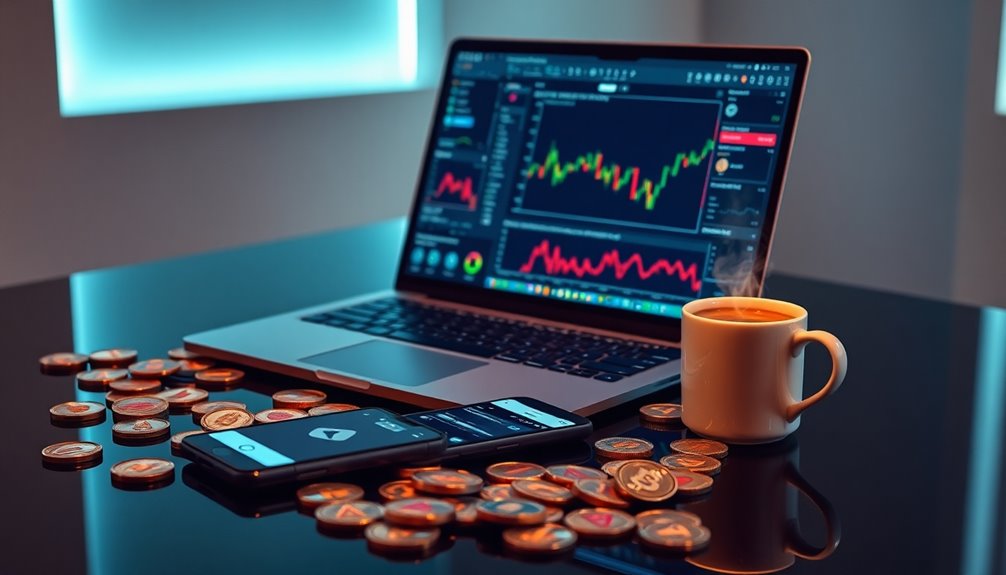Understanding cryptocurrency trading volume is crucial for your trading success. It tells you how much of a cryptocurrency has been bought and sold over a specific time, revealing market activity. High trading volume usually means better liquidity, which allows for faster trade execution and tighter price spreads. You can assess investor sentiment and price strength by observing volume changes; increased volume often indicates strong market trends. However, be wary of manipulation tactics that can distort this data. By grasping these concepts, you can make more informed decisions, and there's even more to discover about trading strategies and risk management.
Key Takeaways
- Trading volume measures the total cryptocurrency exchanged within a specific timeframe, reflecting market liquidity and activity.
- High trading volume indicates a liquid market, facilitating better pricing and quicker trade execution.
- Volume trends can signal market sentiment; increasing volume often confirms price movements, while decreasing volume may indicate weakening momentum.
- Market manipulation techniques, like pump and dump, can distort trading volume, misleading traders and affecting market stability.
- Analyzing volume patterns with tools like OBV and VWAP enhances trading strategy effectiveness and risk management.
Definition of Trading Volume
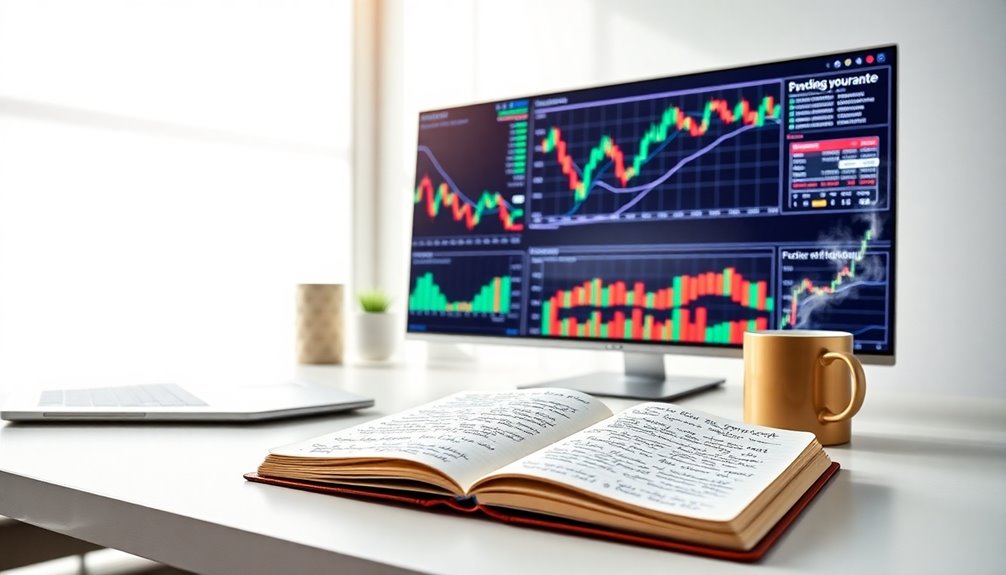
Trading volume is a key metric that quantifies the total amount of a cryptocurrency exchanged over a specific period, typically a day.
It measures the total quantity traded, including both buy and sell transactions, and can be expressed in the cryptocurrency itself or in its transaction value in another currency.
Calculating trading volume involves aggregating data from multiple exchanges, summing volumes in various currencies, and determining weighted average prices.
Most calculations occur over a 24-hour timeframe, with updates reflecting real-time market activity. However, be cautious; trading volume can be manipulated through practices like wash trading, so it's vital to consult multiple sources for an accurate picture of market activity and make informed trading decisions. High trading volume often indicates a more liquid market, which can enhance trading opportunities.
Importance of Market Liquidity
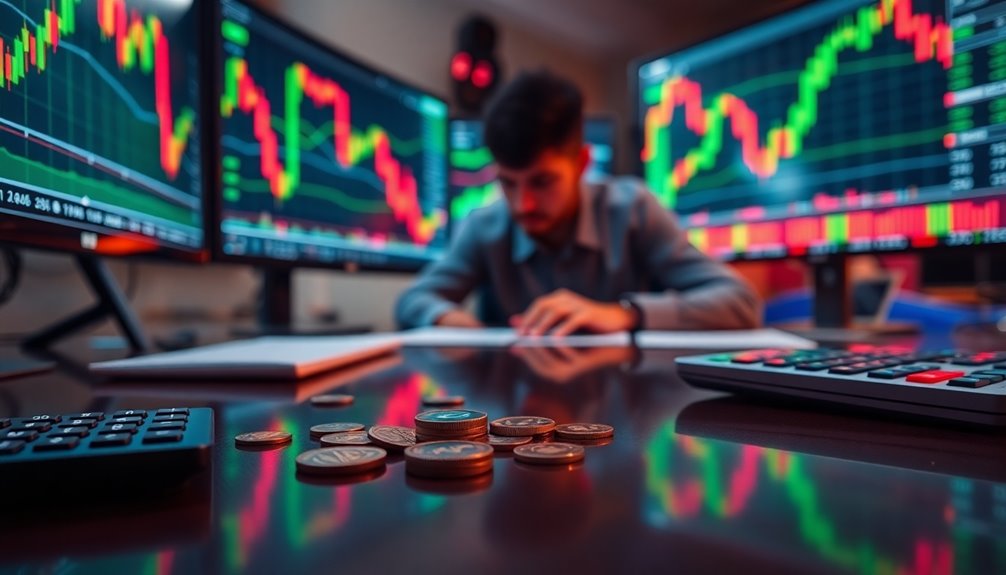
When you're navigating the cryptocurrency market, understanding the importance of market liquidity is crucial. High liquidity allows you to execute trades quickly, as numerous buyers and sellers are active. This environment facilitates better pricing, keeping bid-ask spreads tight and close to market value. Moreover, liquidity minimizes the impact of large orders on prices, helping maintain stability and reducing unexpected fluctuations. In volatile markets, high liquidity ensures you can respond swiftly to price changes without significant delays. Ultimately, a liquid market not only supports efficient trades but also fosters confidence among traders, essential for long-term growth. Additionally, effective liquidity enhances overall trading efficiency and user experience, making it a pivotal aspect of market dynamics.
Insights Into Market Sentiment

Understanding market sentiment can significantly influence your trading decisions, as it reflects the collective emotions and attitudes of investors. You can gauge sentiment through tools like the Fear and Greed Index, which shows whether the market is in a state of fear or greed. Monitoring social media trends and the tone of discussions on platforms like X and Reddit helps you identify bullish or bearish sentiments. High trading volumes can signal strong buying or selling pressure, while on-chain metrics provide deeper insights into market behavior. Additionally, understanding market sentiment can enhance your ability to navigate the volatile crypto landscape effectively. Keep an eye on Bitcoin's dominance; higher dominance typically indicates greed.
Assessing Price Movement Strength
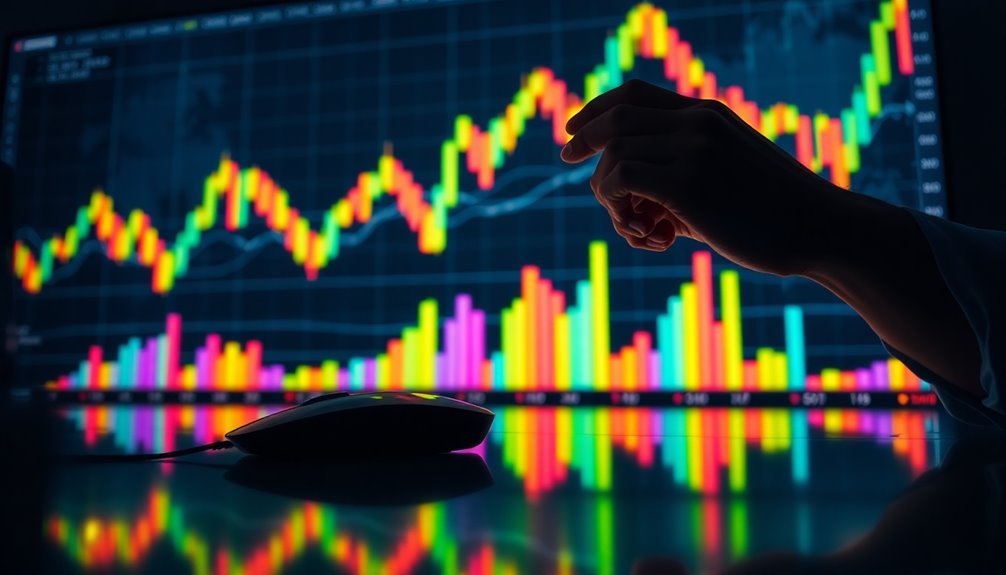
To accurately assess price movement strength, you'll want to closely examine trading volume, as it serves as a vital indicator of momentum. Increasing buying volume typically pushes prices higher, while maintaining that volume is crucial for sustaining momentum. If you notice rising prices accompanied by declining volume, it could signal weakening momentum and a potential reversal. Conversely, falling prices on declining volume might indicate a shift in direction. High volume during price movements confirms the trend's strength, while low volume suggests the opposite. Watch for volume spikes, as they can indicate new momentum or exhaustion. Additionally, understanding support levels is essential, as they signify price points where buying interest may prevent further declines, thereby affecting volume dynamics. Combining tools like the On-Balance Volume (OBV) and the Money Flow Index (MFI) can enhance your assessment, providing a clearer picture of market dynamics.
Relationship With Volatility

While trading volume acts as a catalyst for price movement, it also plays a crucial role in shaping market volatility.
There's a positive correlation between trading volume and volatility; as trading volume rises, so does volatility. This has been confirmed across various studies on cryptocurrencies like Bitcoin. Unexpected trading volume can significantly impact volatility, explaining around 20% of price fluctuations. Recent research indicates that unexpected trading volume can be a key explanatory variable for spot volatility in Bitcoin markets.
In more efficient markets, higher trading volume typically leads to more stable prices, while low volume can create wider spreads and increased volatility.
Macroeconomic factors, technological advancements, and institutional adoption also influence this relationship.
Understanding how trading volume affects volatility can help you navigate the unpredictable nature of cryptocurrency markets.
Identifying Market Activity
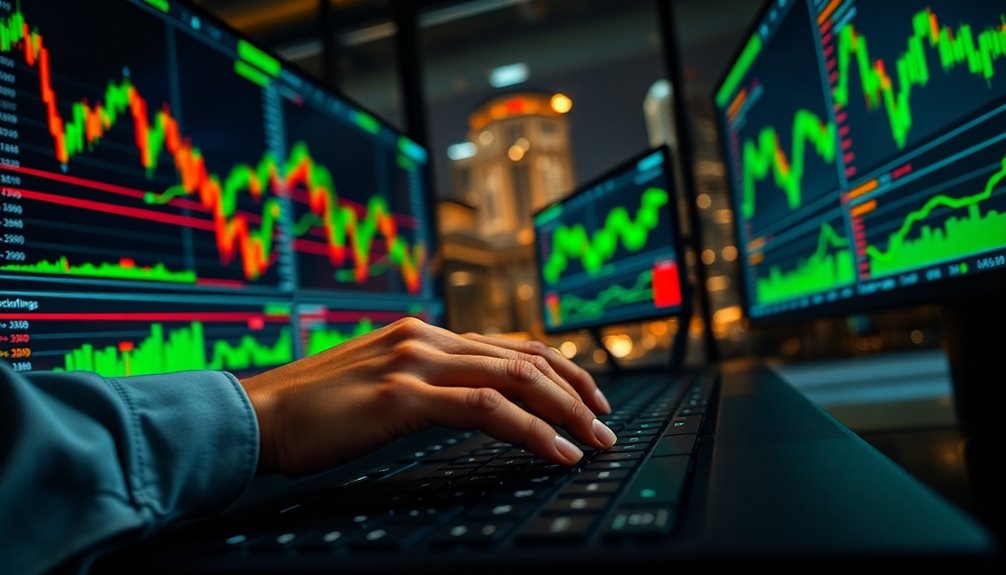
Trading volume not only influences volatility but also provides key insights into market activity. When you notice high trading volume, it indicates strong liquidity, allowing you to buy or sell assets with minimal price fluctuations. This liquidity is crucial for executing trades efficiently and reducing the risk of price slippage. A bustling market with high volume means more buyers and sellers are engaged, which helps maintain competitive prices and market stability. Additionally, trading volume aids in price discovery, reflecting the fair value of assets. By analyzing volume trends, you can gauge market sentiment, identify periods of high activity, and assess overall market health, giving you a clearer picture of where the cryptocurrency landscape is heading. Furthermore, understanding volume dynamics enhances overall market health and is essential for making informed trading decisions.
Manipulation and Its Impact
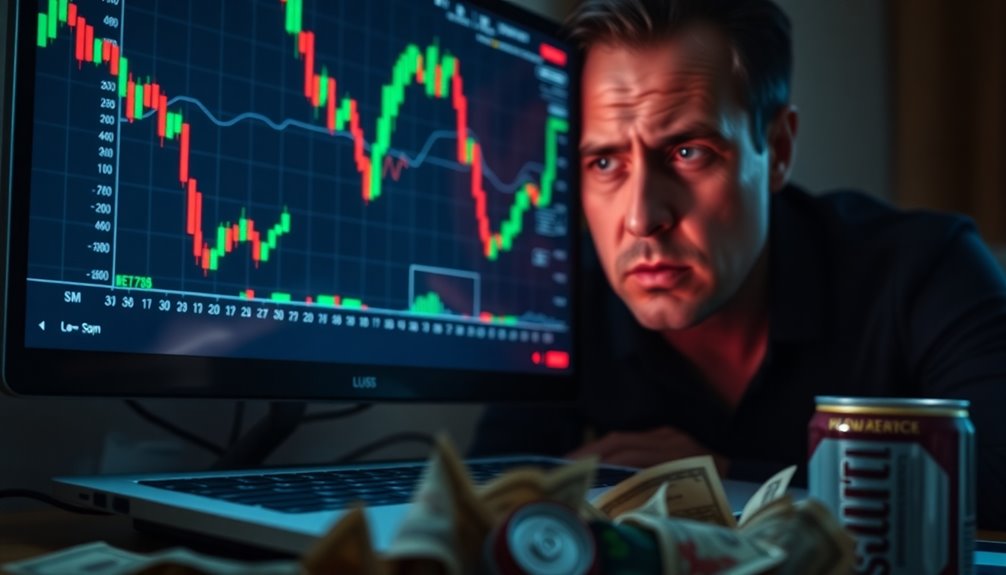
Market manipulation can severely distort the cryptocurrency landscape, leading to misguided decisions for unsuspecting traders. Techniques like pump and dump schemes allow whales to inflate prices, leaving smaller investors with losses after they sell off at peak levels. Spoofing creates fake demand, tricking you into thinking prices are rising when they aren't. Additionally, artificially inflating trading volume can mislead you about market interest, affecting your technical analysis. Sell walls and puncture tactics manipulate prices and breed volatility, making it hard to trust market signals. Ultimately, these manipulative tactics can lead to poor trading decisions, increased volatility, and liquidity issues, compromising your ability to make informed choices in the market. This increased volatility is often a result of total volume traded, which correlates directly with market efficiency.
Analyzing Data Sources

How can you make sense of the vast array of data sources available for analyzing cryptocurrency? Start by utilizing official APIs from exchanges, which provide valuable historical and current data on prices and trading volumes.
While direct access is an option, it often requires developer skills and is limited to a few exchanges. Consider third-party data providers like CoinAPI, which simplify access to standardized data from numerous exchanges, making comparisons easier. These providers offer low latency and multiple data formats for your convenience. Additionally, leveraging real-time market data can significantly enhance your trading strategies and risk mitigation. Explore various types of cryptocurrency data, such as market prices and trading volume, to deepen your analysis.
Integrating this data with tools like On Balance Volume can enhance your understanding of market dynamics.
Strategies for Traders

Developing effective strategies is crucial for navigating the complexities of cryptocurrency trading. Start by analyzing volume patterns; look for volume spikes that signal potential price movements and monitor for exhaustion signals to identify when a price move may end.
Utilize volume indicators like On-Balance Volume (OBV) and Volume Weighted Average Price (VWAP) to gauge market dynamics and confirm trends. Don't overlook the order book depth; it offers real-time insights into buy and sell orders, helping you spot support and resistance levels. Additionally, high trading volume can enhance market liquidity, making it easier to execute trades without significant price slippage.
Consider employing trading strategies like scalping during high-volume periods or breakout trading to seize significant volume increases. Always be cautious of false signals, especially during volatile market conditions. Combining these approaches can enhance your trading effectiveness.
Frequently Asked Questions
How Can I Track Trading Volume for Specific Cryptocurrencies?
To track trading volume for specific cryptocurrencies, you can use live volume monitors and crypto screeners.
Tools like GoodCrypto let you monitor real-time trading data across various exchanges. Set up custom alerts to notify you of significant volume changes or unusual activity.
You can also compare trading volumes across different platforms to find the most liquid options.
What Tools Are Available for Analyzing Trading Volume Effectively?
To analyze trading volume effectively, you can use tools like On Balance Volume (OBV) and the Money Flow Index (MFI).
OBV helps you identify buying or selling pressure, while MFI indicates overbought or oversold conditions.
Volume Weighted Average Price (VWAP) gives insights into average prices.
Additionally, consider Volume Profile and analyzing order books for deeper market understanding.
Real-time volume tracking with alerts can keep you informed of significant volume changes.
How Does Trading Volume Affect Cryptocurrency Mining?
Trading volume significantly impacts cryptocurrency mining.
When trading volume rises, prices often increase, enhancing your mining profitability. Higher volumes can lead to more transactions, boosting transaction fees you earn.
Conversely, low trading volume can depress prices and profitability, making it tough to sustain your operations.
Additionally, fluctuations in trading volume affect the network hashrate, which influences the overall security and efficiency of the blockchain you rely on for your mining activities.
Can Trading Volume Influence Cryptocurrency Regulatory Decisions?
Yes, trading volume can definitely influence cryptocurrency regulatory decisions.
When you see high trading volumes, regulators often pay closer attention, as it can signal increased market activity and potential manipulation. If volumes drop significantly, it may prompt reviews to assess market health.
Conversely, clear legal frameworks that boost trading volumes can lead to more stable regulations, fostering greater investor confidence and encouraging a healthier market environment for everyone involved.
What Are Common Misconceptions About Trading Volume in Crypto?
You might think high trading volume always means a strong market, but that's not the case.
Sometimes, it signals manipulation or wash trading. Also, low volume doesn't necessarily indicate a project's failure; it could reflect market conditions.
Remember, volume data needs careful analysis, as it can vary with time frames and external events.
Always combine volume insights with other indicators to get a clearer market picture.
Conclusion
In conclusion, understanding cryptocurrency trading volume is essential for navigating the market effectively. It helps you gauge liquidity, assess market sentiment, and evaluate price movements. By recognizing the relationship between volume and volatility, you can better identify market activity and potential manipulation. Utilizing reliable data sources and incorporating volume analysis into your trading strategies can significantly enhance your decision-making. Stay informed and adapt your approach to maximize your success in the ever-evolving world of cryptocurrency trading.

